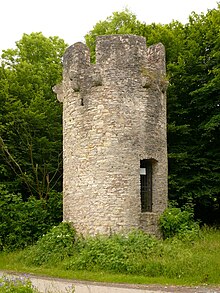Ring rings
|
Ring rings
City of Göttingen
Coordinates: 51 ° 33 ′ 31 ″ N , 10 ° 0 ′ 22 ″ E
|
|
|---|---|
| Height : | 304 (270-345) m |
| Area : | 7.09 km² |
| Residents : | 1002 (December 31, 2018) |
| Population density : | 141 inhabitants / km² |
| Incorporation : | 1st January 1973 |
| Postal code : | 37077 |
| Area code : | 0551 |
|
Roringen in the urban area of Göttingen
|
|
Roringen is a village in southern Lower Saxony and the northeastern district of the Lower Saxony university town of Göttingen . It is located about 6 kilometers northeast of the city center directly on federal highway 27 .
history
The place was first mentioned in a document in 1162 through a letter from Pope Alexander III. to the neighboring Augustinian monastery in Nikolausberg , in which he gave the monastery a. a. confirmed ownership of four Hufen Landes in Roringe . Further written mentions in the 12th century name the place as Rariggen (1170) and Rorunghen (1189). The Junker family of the von Roringen came from Roringen, whose first representative, Manfried von Roringen, is mentioned in 1025. They owned various goods in the area around the town, were tenant owners of the noble lords of Plesse and also owned properties in Bovenden . Several representatives of the sex entered the Reinhausen monastery and sometimes reached leading positions there, such as Hans von Roringen's brother, who was referred to as Herr Dionysius and held the title of prelate . He died in 1300, a year later Günther von Roringen was named, who was referred to as Prior . In the 14th century the city of Göttingen acquired the village from the Duke of Brunswick , which administered the village until the middle of the 19th century. At that time she had the Duke give her permission to dig a Landwehr in the city and to have several waiting lines set up. A direct result can still be found today in the Berwinkelswarte. In the course of the Hildesheim beer feud from 1481 to 1486, along with other villages in the area, Roringen was also devastated. From 1848 until the regional reform , Roringen was an independent municipality. On January 1, 1973, it was incorporated into the district town of Göttingen.
The town's population has grown rapidly in recent decades, but in 2009 it fell slightly below the 1,000-inhabitant mark, which was exceeded again in 2016. In 2018, 1002 people lived in Roringen.
coat of arms
The local coat of arms of Roringen shows a green hill on a red background on the lower edge, on which a watch tower stands in gold. In the middle of the watchtower there is a bear, modeled on the Berlin coat of arms.
Culture and sights
St. Martin Church
The Evangelical Lutheran Church of St. Martin in Roringen was first mentioned in a document in 1254. Back then the patron saints were the Dukes of Braunschweig; today it is the city of Göttingen. The originally flat-roofed nave was designed with a wooden barrel ceiling in the 19th century.
In 1999, August von Werder's organ from 1846 and a large part of the interior of the church were destroyed by fire. As a replacement, the Hillebrand brothers built a new instrument with 16 registers on two manuals and a pedal in 2003.
The church consists of a medieval, almost square west tower with a pyramid roof and a church hall with a gable roof and a crooked hip that was added to the east in 1747/48.
Berwinkelswarte
The ruins of the Roringer Warte or Berwinkelswarte are located east of the village on the B 27 at an altitude of 323 m above sea level. NN . It was built in 1408/09 as part of the Göttingen city fortifications and is still preserved as a tower made of quarry stone. The roof is missing.
Web links
- Roringen's website
- Ring rings. In: goettingen.de. City of Göttingen, September 2013, archived from the original on July 15, 2017 ; accessed on December 28, 2019 .
Individual evidence
- ↑ Kirstin Casemir, Uwe Ohainski, Jürgen Udolph: The place names of the district of Göttingen . In: Jürgen Udolph (Hrsg.): Lower Saxony Place Name Book (NOB) . Part IV. Publishing house for regional history, Bielefeld 2003, ISBN 3-89534-494-X , p. 347 f .
- ↑ Joachim Meier: Origines Et Antiqvitates Plessenses. That is: Pleiß origin and memorabilia . König, Goslar 1713, p. 338 f .
- ↑ Otto Fahlbusch: The district of Göttingen in its historical, legal and economic development . Heinz Reise-Verlag, Göttingen 1960, p. 62 .
- ^ Federal Statistical Office (ed.): Historical municipality directory for the Federal Republic of Germany. Name, border and key number changes in municipalities, counties and administrative districts from May 27, 1970 to December 31, 1982 . W. Kohlhammer GmbH, Stuttgart and Mainz 1983, ISBN 3-17-003263-1 , p. 207 .
- ↑ 020.21 City of Göttingen: Historical population figures - population in the city districts from 1896 to 2018 in the Göttingen Statistical Information System (PDF file), accessed on December 28, 2019.
- ↑ Lecture on the Roringer coat of arms from a historical-heraldic point of view on ratsinfo.goettingen.de, accessed on October 27, 2013
- ↑ Description of the church on www.roringen.de .
- ^ Roringer Warte on the website of the city of Göttingen
- ↑ Roringer Warte on warttuerme.de



